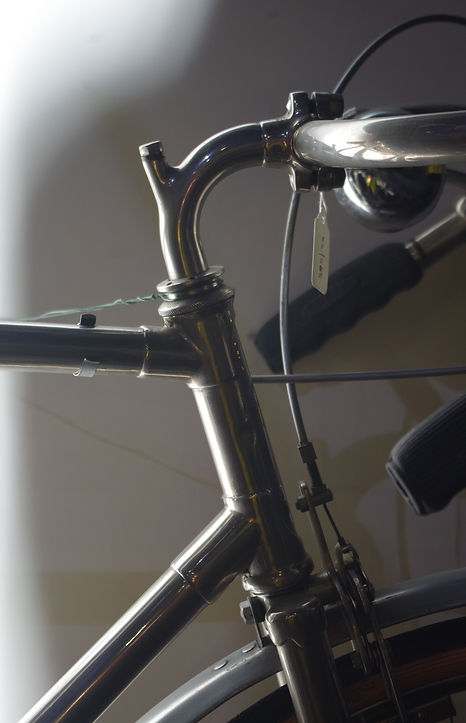
THIS SITE USES GOOGLE ANALYTICS TO ANALYSE TRAFFIC. CONTINUING TO USE THIS SITE MEANS YOU ACCEPT THE USE OF COOKIES.WE DO NOT COLLECT PERSONAL DATA LEARN MORE OR SEE OUR PRIVACY POLICY
SEVEN DAY CYCLIST
CYCLING, BUT NOT USUALLY RACING
LATEST UPDATE NOVEMBER 18th 2025
HOW DO WE REACH THE OVERALL RATINGS FOR PRODUCTS WE REVIEW?
A VISIT TO THE NATIONAL CYCLE MUSEUM

The Automobile Palace, close to the centre of Llandrindod Wells, is pretty unmistakable. Inside Steve Dyster found bicycles rather than automobiles - machines ranging from a Hobby Horse through to the most modern machines.
Run by volunteers, our visit to the National Cycle Museum, coincided with the duty day of “Friday” Bob and Allan. Allan described Bob as “the Mechanic” - and a lot of skill and knowledge, not to mention ingenuity, he must have to work on the fleet Allan introduced me and the family to.
He guided me through a selection of machines designed to cover the evolution of the Hobby Horse, through Boneshakers, Ordinaries and their progeny, through to Safety bicycles and the fundaments of the modern bicycle. A familiar story to some, and, as ever, there are the odd leaps and bounds and dead-ends of invention. We talked about the pros and cons of the designs and wondered how many ideas were discarded before being whittled down to the few that were adopted, let alone the handful that became the modern bicycle.
There’s a replica of Kirkpatrick Macmillan’s machine and an early French machine …. but we won’t step into the deep bog of crediting the invention of the bicycle to a particular individual … not here anyway. It is the start of the exhibition and there is much more to look at.



Good to see, in my opinion, was some prominence being given to JB Dunlop - seems to me that the development of pneumatic tyres is often under-represented on the history of bicycles. However, many of the early machines have no attribution, built as they were by a now forgotten mechanically-minded smith.
More modern machines begin to show the diversification with specific types of cycling in mind, at first narrow, but rapidly broadening into utility bikes, racers, tourers, and more. Equally, the various components and accessories hold a lot of interest for the enthusiast. I was drawn initially to peculiar transmissions, then to front lights, handlebars and saddles - surely a sign of a well-spent youth.
By now, Allan and I were chatting away happily. He told me a little of his exploits in 1960s national time-trials; we noted a tandem that gave control over the gears to the stoker - a dangerous notion, in my opinion; we pondered the rear end of a “Curly” Hetchins - definitely a cycling enthusiasts pastime; looked at the popular clubman’s bikes. Alan’s favourite machine is a Colnago - Italian style winning over sentiment. Personally, I’d really like to ride any of the machines from before 1918, even a tricycle. there were a number built for three, so the dog would have had to trot by the side. Don’t think we would have got much speed up.
There’s often a gentle reminder of passing years when a middle-aged individual looks round a museum. A Dawes Galaxy …. hang on, it is not that much older than my Supergalaxy … what is it doing in a museum!
Modern adapted track machines make a fitting end to the main displays.
In some ways there is almost too much to look at. I went through phases of marvelling, historical interest, nostalgia, surprise and came away with the feeling that I could stay longer. This is, undoubtedly, a must for the cycling enthusiast - especially the cycling enthusiast who wants a break when pedalling round mid-Wales (a not uncommon desire).




The latest bike to arrive was propped up in reception. A bright green Holdsworth, awaiting Bob’s gentle attention. A reminder that all the machines in the museum have, at some time or another - quite possibly several times over - been ridden by cyclists, probably keen one’s. They’d invested their hard-earned money, set-off on journeys, maybe fallen in love - with bike or future spouse. Equally, most were made by craftsmen, in some cases pioneers and inventors, or artists.
Comparison with the hand-built bikes at Bespoked is unfair, but many of the machines are marked by similar creativity and innovation, as well as natty paint-work. Why did the lever chain not catch-on? It would certainly not be out of place on some of the more idiosyncratic bespoke bikes. Spoon brakes may be ineffective in many ways, but, if weight is not a consideration, rod brakes are certainly stylish. Gracefully curved bar stems, ornate front lamps - what advances have been made in that department in the last twenty years! there were bamboo bikes in both exhibitions, too.
The museum also has an extensive on-line archive of cycling related material.
As we walked back to the van, Allan and “Friday” Bob gave us a wave and we headed off having had a happy couple of hours. Even the dog, who, incidentally, got in for nothing, wagged his tail.
www.cyclemuseum.org.uk Take a look at the website before visiting, or give the museum a call on 01597 825531
PUBLISHED APRIL 2017






